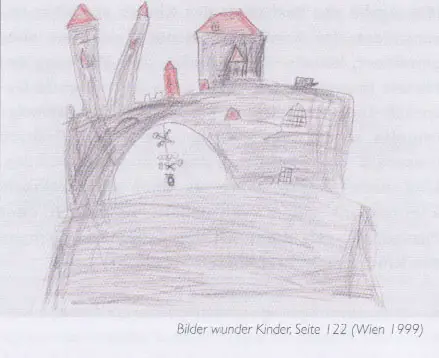Translated by Katja Schütt and Alan Schmukler
Surely, the interpretation of children’s paintings has primarily nothing to do with homeopathy. It is quite rare that the patient’s style of painting points to the indicated remedy. Nevertheless, to consider them is invaluable to recognize family structures or to judge the case dynamic with more security.
For example, if the child’s conflict seems to be diminished in the painting, it may point to the deep action of the remedy, even if the child’s behavior still remains unchanged after taking the remedy.
Often, a clarifying conversation with the parents can help give the child a much healthier position within the family. Last but not least, it would be inexcusable not to recognize a possible abuse or cruelty in the often revealing paintings of children. [1]
The first phases of the normal development of children’s paintings are divided into the so-called ”Scribbling stage“, in which children primarily express their joy in rhythmic movements and the generation of marks and the subsequent ”Schematic stage“, which is more objective, and where they use simple schemes to paint their pictures, like streaks for painting the extremities or a circle for any volume. The Schematic stage also includes drawings in which the child puts the streaks representing the extremities directly on the head (circle-volume). The Schematic stage is followed by a phase, which starts with ”adolescence“ at about the age of eight years, when attempts are made to paint more naturalistically.
The paintings of each stage reveal much information when one knows how to interpret them, using knowledge of child psychology. The following scheme demonstrates the arrangement of areas on the paper:
-
Remembrance
Fantasy
Dream
Connection with the origin
Egocentricity
The I projected towards the future
Anxiety
Insecurity
Desire
Past Present Future
(upper area, on the left side of the page): Intellectual world
(middle area): Reality/Current things
(lower area): Material things
Aside from the positioning on the paper, the proportions used provide information about the sensations of the child. Arms symbolize the connection to the outer environment; large arms point to a strong communication need; short arms to insecurity and anxiety. Hands are used by parents or significant others to touch and caress, but possibly for beating too.
Graphology analyses the style of drawing lines when painting. Complacent “sensible” children usually paint in a non-dynamic fashion, using thin streaks, whereas self-confident and impulsive children prefer a more powerful style, painting with streaks.
The choice of colors also provides important information. Preference for the color red may signify activity and vitality, but can also indicate aggression and violence. It is important to consider what area is painted with red. For example, it would be peculiar if the genital area of a person is painted in red. The dominant use of the color black points to certain anxieties and sadness.
Sign tests
There are many well researched tests which are easy to use in one’s practice with children. I used to send them with paper and colored pencils into the waiting room, to provide a concrete task, and so they would not be influenced by the presence of their mother at the interview.
There are the established tests that involve trees or houses, which give a lot of information about the patient. Quite astonishing hints can be derived from paintings of the family, which even laypersons can interpret using some empathy: The child is given the task to paint his family, including himself. First, it is interesting to see which family members are painted. Occasionally the aunt is given higher value than his own mother. It is also important how family members are positioned in relation to each other. Do they hold each other’s hands? Do they touch each other? Does someone stand apart? Did the child paint someone disproportionately large (the dominant person) or small (a possible rival, who is being ”belittled“)? Which colors are used to paint single parts and what are the facial expressions?
A very useful test is letting patients paint their family as animals. I personally prefer this kind of test, as it easier to talk about it later with the child. The animals serve to represent the actual family members and it is easy to ask the child “The wolf (father) has quite large teeth (and a red muzzle)! Is he mad?” It is also interesting to see how the animals or family members are positioned (see the scheme above). In what direction are they oriented, and where are they looking? Is someone, or are some bodily part, covered by something or even completely omitted? This may indicate a tendency to hide, or point out a problematic area.
A nine year old Stramonium-patient of mine, whose diffuse anxieties of unknown origin disappeared after taking the remedy, used to paint her whole family as a horse family, all horses standing on firm ground and moving in the same direction. However, she only positioned herself anchorless in the air.
One patient, fourteen year old and highly intelligent had a pronounced problem of aggression and suppressed emotions. He is an excellent painter, but does not use colors, arguing ”I don’t like colors“. During the course of homeopathic treatment it is expected that he will express his emotions and paint with colors.
[1] At this point I want to warn about over-interpretations. Often, innocent family members have been accused of sexual abuse after therapeutic interviews. Also, a child should never been asked directly when presuming this due to his painting. Neither should one be tempted to certain “propositions“ or self interpretations.
References
-
Brem-Gräser, Luitgard:„Familie in Tieren. Die Familiensituation im Spiegel der Kinderzeichnungen“, Ernst Reinhardt Verlag, München, 2001. ISBN 3-497-01567-9
-
Brochmann, Inger: „Die Geheimnisse der Kinderzeichnungen“. Verlag Freies Geistesleben & Urachhaus GmbH, Stuttgart, 1997. ISBN 3-7725-1673-4
-
Crotti, Evi und Magni, Alberto: „Die geheime Sprache der Kinder. Kinderzeichnungen richtig deuten“. Beust Verlag, München, 1999. ISBN: 3-89530-022-5
-
Erhard, Rotraut und Tatzer, Ernst (Hrsg.): „Bilder wunder Kinder. Botschaften verletzter Seelen“. Ausstellungskatalog des NÖ Heilpädagogischen Zentrums, Hinterbrühl. ISBN 3-901811-03-6
-
Koch, Karl: „Der Baumtest“. Verlag Hans Huber, Bern, 2000. ISBN 3-456-83519-1
-
Manes, Sabina: „Mama ist ein Schmetterling, Papa ein Delphin. Kinderzeichnungen verstehen.“ Piper Verlag, München, 1995. ISBN 3-492-22558-6
-
Richter, Hans-Günther: „Sexueller Missbrauch im Spiegel von Zeichnungen“. Peter Lang GmbH Europäischer Verlag der Wissenschaften, Frankfurt 1999. ISBN: 3-631-34977-7
-
Schuster, Martin: „Kinderzeichnungen. Wie sie entstehen, was sie bedeuten“. Springer-Verlag Berlin, Heidelberg 1994. ISBN 3-540-57042-X
-
Schuster, Martin: „Psychologie der Kinderzeichnung“. Hogrefe-Verlag Göttingen 2000. ISBN 3-8017-1284-2
© This article was published in Homöopathie Zeitschrift I/02, p. 71 ff. and is republished with the gracious permission of the author and publisher.








